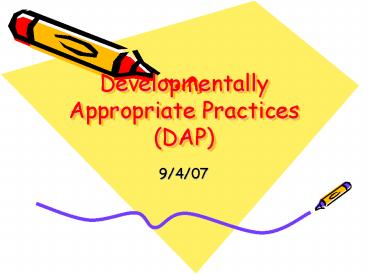Developmentally Appropriate Practices (DAP) - PowerPoint PPT Presentation
1 / 17
Title:
Developmentally Appropriate Practices (DAP)
Description:
What does a DAP classroom look like? ... for learning in: language, literacy, math, science, health, art and music. ... – PowerPoint PPT presentation
Number of Views:3818
Avg rating:3.0/5.0
Title: Developmentally Appropriate Practices (DAP)
1
Developmentally Appropriate Practices (DAP)
- 9/4/07
2
Agenda- 9/4/07
- Finish presenting Case Studies
- Developmentally Appropriate Practices (DAPs)
PowerPoint - Class map of the Big Ideas
3
History
- Due to the result of Sputnik in the late 1950s
curriculum was revised to focus on having
children do more sophisticated work earlier in
their school careers. - Decisions about curriculum were made by
individuals that had little knowledge of young
childrens learning.
4
History
- Parents became more concerned with scores and
achievement than they were with their childs
becoming a successful learner. - Many inappropriate programs resulted.
5
Developmentally Appropriate Practice-Origin
- National Association for the Education of Young
Children (NAEYC) developed a document that
defined Developmentally Appropriate Practice from
birth-age 8. - These practices seem to reflect the consensus of
early childhood professionals.
6
DAPs
- Definition- Developmentally appropriate programs
are those that reflect childrens natural
learning abilities and interests, and assist them
in growing socially, emotionally, physically, and
intellectually.
7
DAPs
- Emphasizes stages of child growth and development
and focuses on - Rates that children learn
- Ways that children learn
- Hands-on, active learning
- Conceptual learning that leads to understanding
along with acquisition of basic skills
8
DAPs focus on (cont.)
- Meaningful, relevant learning experiences
- Interactive teaching and cooperative learning
- Broad range of relevant content, integrated
across subjects - Development of learning processes such as
reading, writing, thinking, and problem solving - Continuous progress
- Assessment that is on-going and authentic
9
DAPs Discourage
- Rote memorization
- Drill and practice on isolated academic skills
- Teacher lecture
- Repetitive seatwork
- Testing skills in isolation
10
What does a DAP classroom look like?
- Recognizes and accepts individual differences in
childrens growth patterns and rates by setting
realistic curriculum goals that are appropriate
to their developmental levels.
11
What does a DAP classroom look like?
- Educates the whole childwith attention to
physical, social/emotional and intellectual
developmental needs and interests - Responds to the needs of children as developing,
thinking individuals by focusing on the processes
of learning rather than skills, content and
products.
12
What does a DAP classroom look like?
- Provides multiple opportunities for learning with
concrete, manipulative materials that - Are relevant to children's experiential
background - Keep them actively engaged in learning and
discovering through use of all the senses,
leading to more input upon which thought is
constructed
13
What does a DAP classroom look like?
- Provides a variety of activities and materials by
incorporating - Learning activities that encourage active
participation through hands-on activity,
communication and dialogue - Large blocks of time to pursue interests
- Time to ask questions and receive answers that
develop concepts and ideas for use at varying
levels of difficulty and complexity - Time to reflect upon and abstract information
when encountering different viewpoints from peers.
14
What does a DAP classroom look like?
- Views play as fundamental to childrens learning,
growth and development, enabling them to develop
and clarify concepts, roles and ideas by testing
and evaluating them through use of open-ended
materials and role-enactment - Play further enables children to
- develop fine and gross motor skills
- learn to share with others
- see others points of view
- be in control of their thoughts and feelings
15
What does a DAP classroom look like?
- Provides opportunities for the use of
multicultural and nonsexist experiences,
materials and equipment that enhance childrens
acceptance of self and others and enables them to
accept differences and similarities among people,
including those with disabilities.
16
What does a DAP classroom look like?
- Embraces the teaching of all content areas,
presented as integrated experiences that develop
and extend concepts, strengthen skills and
provide a solid foundation for learning in
language, literacy, math, science, health, art
and music.
17
What does a DAP classroom look like?
- Allows children to make choices and decisions
within the limits of the materials provided,
resulting in increased independence, attention,
joy in learning and feelings of success necessary
for growth and development.































